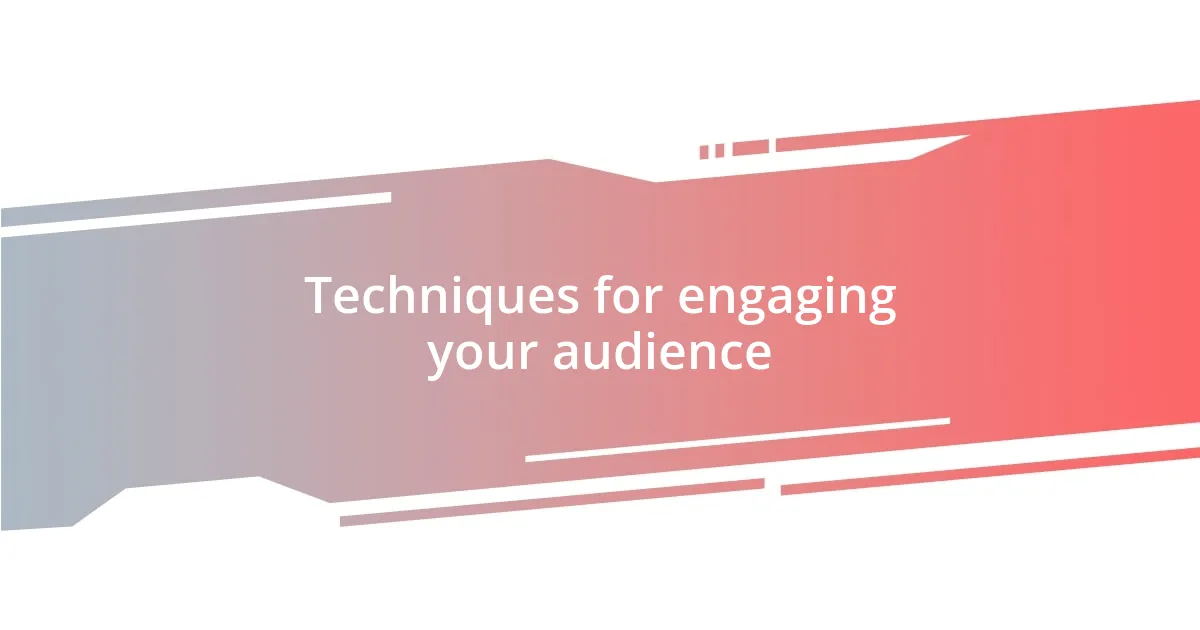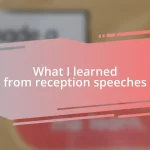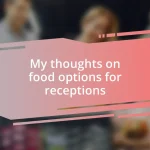Key takeaways:
- Speeches connect audiences through shared experiences, emotional appeal, and relevant storytelling.
- Key elements of effective speeches include clarity, emotional connection, and strong delivery techniques.
- Engaging your audience can be enhanced through personal stories, interaction, and varying vocal dynamics.
- Authenticity and a strong opening create lasting impressions, encouraging audience reflection and action.

Understanding the purpose of speeches
When I think about the purpose of speeches, I often recall that moment at my best friend’s wedding. The speaker’s words didn’t just celebrate love; they connected everyone in the room. Isn’t it fascinating how a few carefully chosen words can elicit laughter or even tears, uniting people in shared moments?
Speeches serve as a platform for expression, whether it’s conveying gratitude, inspiring action, or sharing important information. I remember attending a conference where a speaker passionately discussed the impact of climate change. I felt the urgency in their voice, driving home the message that our actions matter. How powerful is it that a speech can stir hearts and inspire change?
Additionally, the purpose of a speech often hinges on its audience. Reflecting on my own experiences, I’ve learned that tailoring a message to the listeners makes all the difference. What resonates with one group might fall flat with another. It’s a reminder that understanding your audience is crucial—don’t you agree?

Key elements of effective speeches
When crafting an effective speech, clarity is paramount. I once delivered a toast at a family gathering, and I realized that when my points were straightforward, everyone was engaged. They could follow my thoughts easily, leading to laughter and connection. This experience reinforced that a concise message resonates more than a lengthy one filled with jargon.
Emotional appeal is another vital element. I vividly recall a motivational speaker who shared a personal story about overcoming obstacles. It was his vulnerability that drew the audience in. I also felt compelled to reflect on my challenges, echoing his sentiments. This moment highlighted how shared experiences foster connection and encourage listeners to engage with the message emotionally.
Finally, strong delivery can elevate even the simplest of speeches. I remember seeing a speaker who used gestures and varied tone, which brought their words to life. It amazed me how those elements could transform a mundane message into something memorable. A lively presence can inspire and move an audience, making delivery just as important as the content itself.
| Key Element | Description |
|---|---|
| Clarity | Ensuring the message is straightforward and easy to follow, allowing the audience to engage more effectively. |
| Emotional Appeal | Connecting with the audience on a personal level through relatable stories and experiences that evoke feelings. |
| Strong Delivery | Utilizing voice modulation, gestures, and body language to enhance the message and engage the audience dynamically. |

Techniques for engaging your audience
When it comes to engaging your audience, storytelling is an incredibly powerful technique. I remember listening to a speech at a community event where the speaker shared a heartfelt story about their journey. As they narrated their challenges and triumphs, I could see the audience leaning in, captivated by the narrative. It reminded me how effective a well-told story can be in drawing people in and making them feel part of the experience.
To make your speech more engaging, consider these techniques:
- Use Personal Stories: Sharing relevant personal experiences can create an emotional bond with your audience.
- Encourage Interaction: Ask questions or invite audience participation to keep them engaged and attentive.
- Vary Your Tone and Pace: Changing your vocal dynamics can emphasize key points and maintain interest throughout the speech.
Each of these strategies can significantly enhance your connection with the listeners, creating a memorable experience that stays with them long after the speech is over. When I’ve employed these techniques in my own speaking engagements, I’ve noticed that they not only keep the audience engaged but also leave them reflecting on the message shared.

Personal storytelling in speeches
Personal storytelling in speeches is an art that can transform a good speech into a great one. I recall a time when I incorporated a personal story about my first experience with public speaking. As I shared my nervousness and the chaos that ensued, I noticed the audience chuckling and nodding in recognition. It was a reminder that our vulnerabilities often resonate deeply with others, fostering a sense of camaraderie.
Think about this: How often do you remember stories over facts? For me, it’s every time. I’ve found that weaving in anecdotes makes the content not just relatable but also memorable. During a speech at a friend’s wedding, I recounted quirky moments from their relationship. The laughter and warmth that enveloped the room were proof that personal tales can elevate a moment, turning a speech into a shared experience.
When faced with the choice between stating facts or sharing a narrative, I always lean toward storytelling. It’s like holding up a mirror; the audience sees themselves reflected in the tale. For instance, I once spoke about a failure that led to a significant life lesson. Sharing that struggle opened the door for others to share their experiences, creating an environment where everyone felt seen and heard. Personal storytelling goes beyond entertainment; it’s about connection and understanding, which makes speeches truly impactful.

Importance of audience connection
Connecting with an audience is truly the heartbeat of any effective speech. I remember sitting in a packed auditorium, feeling the energy shift as the speaker shared a common struggle we all faced. That moment wasn’t just about the words; it was about feeling understood. Without that connection, the speech would have felt hollow. I always strive to create that same feeling in my own presentations.
When delivering a speech, I’ve found that looking at the audience as individuals rather than just a crowd changes everything. During a greeting for a local charity event, I noticed a woman in the front row who seemed to resonate with my message about perseverance. I shifted my focus to her while sharing my story about overcoming obstacles, and she smiled, as if we were sharing a moment together. It reminded me how audience connection transforms mere dialogue into a shared journey.
Have you ever left a speech feeling like you personally knew the speaker? That’s what audience connection achieves. I was fortunate to experience a talk that felt like a conversation between friends. The speaker asked questions and invited us to reflect on our own experiences. It wasn’t just about listening; it was about engaging on a deeper level that left me thinking long after the event. These interactions are what make speeches memorable and impactful.

Lessons from famous speeches
Famous speeches often highlight the significance of authenticity. Take, for example, Barack Obama’s keynote address at the 2004 Democratic National Convention; he didn’t just list his achievements or campaign promises. Instead, he spoke passionately about the American Dream, drawing on his unique background to create a narrative that resonated with countless people. I clearly remember how his genuine tone inspired optimism and sparked hope. It left me wondering: how often do we prioritize authenticity over perfection in our own speeches?
Another key lesson I draw from notable speeches is the power of a strong opening. Martin Luther King Jr.’s “I Have a Dream” speech begins with a vision that grips the audience’s attention right away. The immediate emotional impact of his words drew people in and made them eager to listen further. In my own experiences, I’ve discovered that if I start with a provocative question or a compelling statement, the audience shifts from passive listeners to engaged participants. It’s as if they’re leaning in, waiting for what comes next—what an electrifying feeling!
Finally, I’ve learned that effective speeches often leave a lasting call to action. Think about Malala Yousafzai’s address to the UN; she not only shared her story of resilience but urged everyone to stand up for education. Her powerful words ignited a movement and inspired many to take tangible steps towards change. I’ve tried to implement this in my presentations as well, encouraging my listeners to connect what they’ve heard to real-world action. Isn’t it fascinating how just a few well-chosen words can galvanize an entire audience into action?

Tips for delivering your speech
When it comes to delivering a speech, the importance of rehearsal cannot be overstated. I vividly recall a time when I didn’t practice sufficiently before an important presentation. The awkward pauses and stumbles made me feel disconnected from my own words. Through that experience, I learned that rehearsing helps me not only memorize my content but fosters a fluid delivery that engages the audience. Have you ever noticed how confident speakers seem to flow seamlessly from point to point? That’s what practice can achieve.
Another tip I find crucial is to embrace your nerves. I used to dread the moments right before stepping onto the stage, feeling my heart race and my palms sweat. Then, I discovered that channeling that energy into my speech creates an authentic vibe. It almost feels like I’m inviting the audience into my world of passion and excitement. Have you ever seen a speaker who looks genuinely thrilled to be there? It’s infectious! It reminds the audience that it’s okay to feel vulnerable.
Lastly, incorporating storytelling into your speech can create a powerful emotional connection. I remember sharing a story about my first experience volunteering for a community project; the joy and challenges I faced were relatable for everyone in the room. By weaving a narrative, I found that my audience not only listened but also felt an emotional stake in my message. Isn’t it interesting how stories allow us to connect on a human level? I encourage you to think about moments in your life that could resonate with your audience. This personal touch can transform your speech from mere information into a shared experience.













